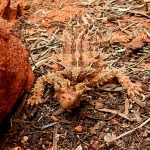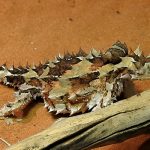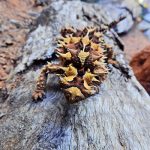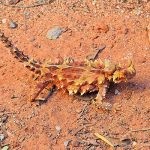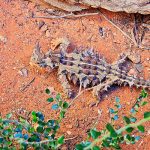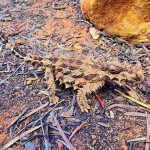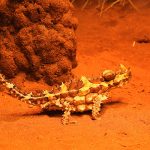THORNY DEVIL
The Thorny Devil is aptly named for its spiky appearance. This small lizard, typically about 20 centimetres long, is covered in sharp, conical spines that serve as a formidable defence against predators. Its coloration is equally remarkable, with a palette of earthy browns and tans that help it blend seamlessly into the desert environment. This camouflage is enhanced by the ability to change colour slightly, from pale colours during warm weather to darker colours during cold weather.
This intriguing creature is found primarily in the arid interior of Australia, including regions of Western Australia, the Northern Territory, and South Australia. The Thorny Devil thrives in sandy deserts and scrublands, where it can be seen slowly ambling across the hot sands in search of food.
Interestingly, the Thorny Devil is not known for vocalising. Instead, it relies on its spiky exterior and camouflaging abilities to communicate its presence and deter threats.
The Thorny Devil has a highly specialised diet, feeding almost exclusively on ants. It can consume thousands of ants in a single day, using its sticky tongue to capture these tiny insects efficiently. This diet is perfectly suited to its desert habitat, where ants are plentiful.
One of the most fascinating features of the Thorny Devil is its ability to collect water. Its skin is covered in grooves that channel moisture from dew or rain directly to its mouth.
Breeding occurs in the spring and early summer. Females lay a clutch of 3 to 10 eggs in burrows dug into the sand. These eggs incubate underground for about three to four months before hatching. The young are independent from birth, needing to fend for themselves in the harsh desert environment.
Thorny Devils can live for about 15 to 20 years, a testament to their adaptability and resilience in the face of environmental challenges.
Currently, the Thorny Devil is not considered to be under significant threat and is classified as Least Concern by conservation authorities. However, like many species, it faces potential risks from habitat destruction and climate change.
The Thorny Devil has a false head on the back of its neck. When threatened, it lowers its real head and presents the false one to confuse predators. It moves in a distinctive, jerky fashion, which may also help to confuse predators and prevent detection. But despite its formidable appearance, the Thorny Devil does have predators, including birds of prey and larger reptiles. Its spiny armour and camouflage provide significant protection, but it must remain vigilant.
The Thorny Devil is a true marvel of adaptation, perfectly suited to its harsh environment. Its unique characteristics and survival strategies make it a symbol of the resilience and diversity of Australian wildlife. Through understanding and appreciating creatures like the Thorny Devil, we can foster a deeper connection with the natural world and the importance of conserving these unique ecosystems.


